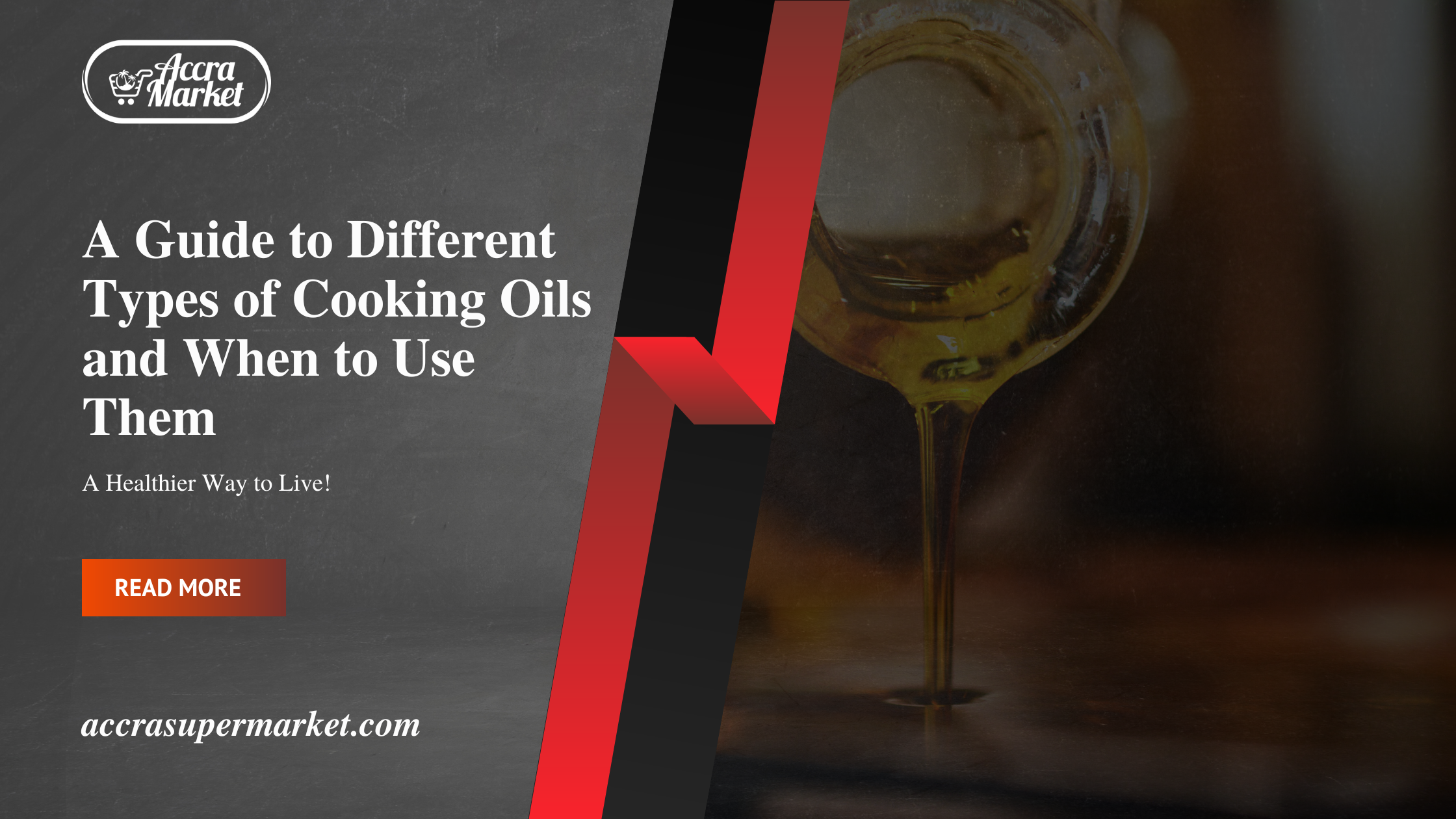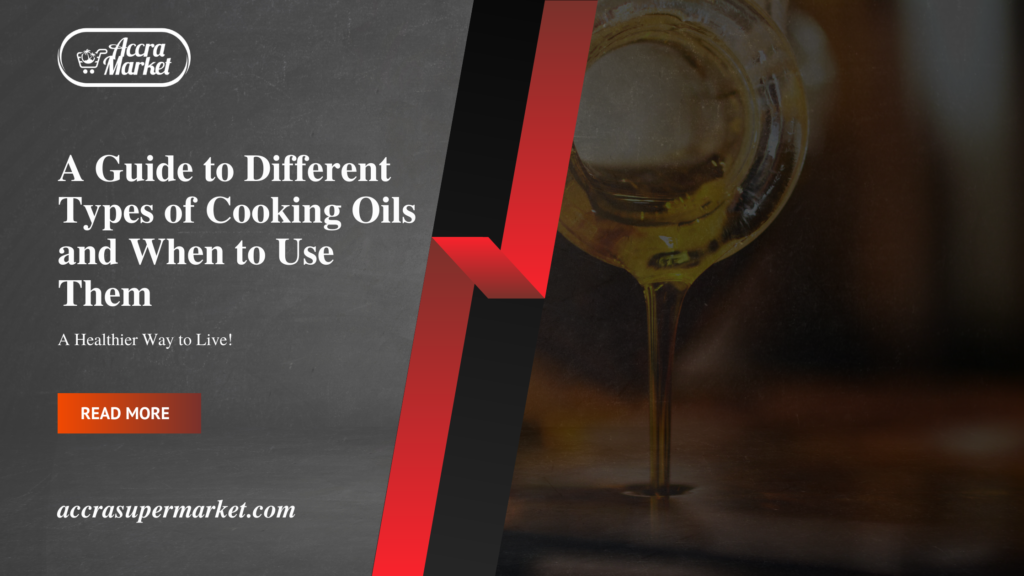Cooking oils are essential components in every kitchen, influencing not only the flavor of your dishes but also their nutritional value. From frying to baking, sautéing to salad dressings, the right oil can make a big difference. With so many options available, choosing the right cooking oil can be overwhelming. This comprehensive guide breaks down the most popular types of cooking oils, their unique properties, health benefits, and the best ways to use them in everyday cooking.

Why Choosing the Right Cooking Oil Matters
The oil you choose can impact:
- Flavor: Some oils are neutral, while others have a strong taste that can enhance or overpower your dish.
- Smoke Point: This determines how hot the oil can get before it begins to burn, affecting its use in high-heat cooking.
- Nutritional Content: Oils vary in their levels of saturated fats, unsaturated fats, and omega fatty acids.
Understanding these factors will help you make better decisions for both your palate and your health.
1. Olive Oil
Overview:
Olive oil is one of the most popular and versatile oils. It’s rich in monounsaturated fats and antioxidants, particularly polyphenols.
Types:
- Extra Virgin Olive Oil (EVOO): Unrefined, robust flavor, packed with nutrients.
- Virgin Olive Oil: Slightly more refined, still good for flavor and health.
- Light Olive Oil: More processed, with a higher smoke point and a neutral taste.
Smoke Point:
- EVOO: ~375°F (190°C)
- Light Olive Oil: ~465°F (240°C)
Best Uses:
- EVOO: Salad dressings, drizzling on vegetables, dips.
- Light Olive Oil: Sautéing, baking, medium to high-heat cooking.
Health Benefits:
- May reduce inflammation
- Supports heart health
- Rich in antioxidants
2. Coconut Oil
Overview:
Derived from the meat of coconuts, coconut oil has a distinct flavor and solidifies at room temperature. It contains medium-chain triglycerides (MCTs), which are metabolized differently by the body.
Types:
- Virgin Coconut Oil: Unrefined, strong coconut flavor.
- Refined Coconut Oil: Neutral flavor, higher smoke point.
Smoke Point:
- Virgin: ~350°F (175°C)
- Refined: ~400°F (204°C)
Best Uses:
- Virgin: Baking, smoothies, sautéing.
- Refined: Frying, roasting.
Health Benefits:
- Contains MCTs that may support weight loss
- Antimicrobial properties
- May improve skin and hair health
3. Canola Oil
Overview:
Canola oil is extracted from the seeds of the canola plant and is known for its mild flavor and affordability. It is low in saturated fat and high in omega-3 fatty acids.
Smoke Point:
~400°F (204°C)
Best Uses:
- Frying
- Baking
- Stir-frying
Health Benefits:
- Heart-friendly
- High in monounsaturated fats
- Contains omega-3s
4. Sunflower Oil
Overview:
Made from sunflower seeds, this oil is high in vitamin E and polyunsaturated fats. It has a clean taste and light texture.
Smoke Point:
~440°F (226°C)
Best Uses:
- Deep frying
- Roasting
- Grilling
Health Benefits:
- Supports skin health due to high vitamin E
- May help manage cholesterol levels
5. Avocado Oil
Overview:
Pressed from the pulp of avocados, this oil has a buttery taste and is high in monounsaturated fats. It’s excellent for high-heat cooking and retains nutrients well.
Smoke Point:
~520°F (271°C)
Best Uses:
- Grilling
- Searing
- Salad dressings
Health Benefits:
- Supports heart and eye health
- Rich in lutein and vitamin E
6. Sesame Oil
Overview:
Sesame oil is a flavorful oil used widely in Asian cuisines. It comes in two forms: light (untoasted) and dark (toasted).
Types:
- Light Sesame Oil: Mild, used for frying.
- Dark Sesame Oil: Strong nutty flavor, used as a finishing oil.
Smoke Point:
- Light: ~410°F (210°C)
- Dark: ~350°F (175°C)
Best Uses:
- Stir-fries
- Dressings
- Marinades
Health Benefits:
- Contains antioxidants like sesamol
- Anti-inflammatory properties
7. Peanut Oil
Overview:
Popular for deep frying, peanut oil has a high smoke point and a slightly nutty flavor. It’s commonly used in Asian and African cuisines.
Smoke Point:
~450°F (232°C)
Best Uses:
- Deep frying
- Searing
- Stir-frying
Health Benefits:
- High in monounsaturated fats
- May improve heart health
8. Grapeseed Oil
Overview:
Extracted from the seeds of grapes, this oil has a clean, neutral taste and is rich in vitamin E and polyunsaturated fats.
Smoke Point:
~420°F (216°C)
Best Uses:
- Sautéing
- Baking
- Salad dressings
Health Benefits:
- Supports skin health
- Contains antioxidants
9. Flaxseed Oil
Overview:
Flaxseed oil is rich in alpha-linolenic acid (ALA), a type of omega-3 fatty acid. However, it has a low smoke point and is best used raw.
Smoke Point:
~225°F (107°C)
Best Uses:
- Smoothies
- Salad dressings
- Drizzling on cooked dishes (not for frying)
Health Benefits:
- Supports brain health
- Anti-inflammatory effects
- Promotes digestion
10. Vegetable Oil
Overview:
Often a blend of various refined oils like soybean, corn, and palm, vegetable oil is a budget-friendly and neutral-tasting option.
Smoke Point:
~400°F (204°C)
Best Uses:
- Frying
- Baking
- Everyday cooking
Health Considerations:
- Often highly processed
- Less nutritional value than cold-pressed oils
Choosing the Right Cooking Oil for Different Methods
| Cooking Method | Recommended Oils |
|---|---|
| Deep Frying | Peanut Oil, Sunflower Oil, Canola Oil |
| Searing/Grilling | Avocado Oil, Light Olive Oil |
| Baking | Canola Oil, Coconut Oil, Light Olive Oil |
| Sautéing | Olive Oil, Grapeseed Oil, Sesame Oil |
| Raw Uses | Extra Virgin Olive Oil, Flaxseed Oil, EVOO |
| Asian Dishes | Sesame Oil, Peanut Oil |
Tips for Storing Cooking Oils
To maintain freshness and nutritional quality:
- Store oils in a cool, dark place.
- Seal tightly after each use to prevent oxidation.
- Use dark glass bottles when possible to reduce light exposure.
- Avoid reusing oils that have been heated to high temperatures multiple times.
Final Thoughts: Choose Smart, Cook Better
Understanding the different types of cooking oils and their best uses helps you get the most out of your culinary efforts. Whether you’re whipping up a stir-fry, roasting vegetables, or dressing a fresh salad, the right oil will elevate your dish in both flavor and health benefits.
As you stock your kitchen, aim for a mix of oils:
- One for high-heat cooking (e.g., avocado or peanut oil)
- One for flavor and finishing (e.g., extra virgin olive oil)
- One for baking or general use (e.g., canola or light olive oil)
Where to Buy Quality Cooking Oils in Accra
If you’re looking to buy premium, fresh, and affordable cooking oils, visit AccraSupermarket.com. You’ll find a wide range of options including extra virgin olive oil, coconut oil, sunflower oil, and more—perfect for every dish and dietary need. Whether you’re preparing traditional Ghanaian meals or exploring international recipes, Accra Supermarket has everything you need to cook confidently and healthily.
oils, visit AccraSupermarket.com. You’ll find a wide range of options including extra virgin olive oil, coconut oil, sunflower oil, and more—perfect for every dish and dietary need. Whether you’re preparing traditional Ghanaian meals or exploring international recipes, Accra Supermarket has everything you need to cook confidently and healthily.
Shop now at AccraSupermarket.com and elevate your cooking game with quality oils delivered right to your doorstep.





